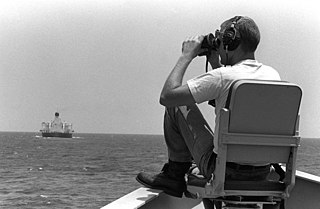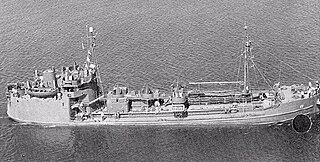
The Strait of Hormuz is a strait between the Persian Gulf and the Gulf of Oman. It provides the only sea passage from the Persian Gulf to the open ocean and is one of the world's most strategically important choke points. On the north coast lies Iran, and on the south coast lies the Musandam peninsula, shared by the United Arab Emirates and Musandam Governorate, an exclave of Oman. The strait is about 90 nautical miles (167 km) long, with a width varying from about 52 nautical miles (96 km) to 21 nautical miles (39 km).
This is a list of aviation-related events from 1984:

USS Samuel B. Roberts (FFG-58) is one of the final ships in the United States Navy's Oliver Hazard Perry-class of guided missile frigates (FFG). Commissioned in 1986, the ship was severely damaged by an Iranian mine in 1988, leading U.S. forces to respond with Operation Praying Mantis. Repaired and returned to duty, the ship served until decommissioned in 2015.

Operation Earnest Will was the American military protection of Kuwaiti-owned tankers from Iranian attacks in 1987 and 1988, three years into the Tanker War phase of the Iran–Iraq War. It was the largest naval convoy operation since World War II.

Operation Praying Mantis was an attack on 18 April 1988, by the United States Armed Forces within Iranian territorial waters in retaliation for the Iranian naval mining of the Persian Gulf during the Iran–Iraq War and the subsequent damage to an American warship.

USS Klakring (FFG-42), an Oliver Hazard Perry class frigate, was a ship of the United States Navy named for Rear Admiral Thomas B. Klakring (1904–1975), who was awarded three Navy Crosses as commander of the submarine USS Guardfish during World War II.

The second USS Seattle (AOE-3), a Sacramento-class fast combat support ship, was laid down on 1 October 1965, at the Puget Sound Naval Shipyard, Bremerton, Washington; launched on 2 March 1968; sponsored by Mrs. William M. Allen, chairman of the board of the Children's Orthopedic Hospital Association, Seattle; and commissioned on 5 April 1969, Capt. Bruce Keener III in command.

The Whiddy Island disaster, also known as the Betelgeuse incident, occurred on 8 January 1979, around 1:00 am, when the oil tanker Betelgeuse exploded in Bantry Bay, at the offshore jetty for the oil terminal at Whiddy Island, Ireland. The explosion was attributed to the failure of the ship's structure during an operation to discharge its cargo of oil. The tanker was owned by Total S.A., and the oil terminal was owned and operated by Gulf Oil.

The USS Manatee (AO-58)—the second vessel of the United States Navy to bear the name—was a Cimarron-class fleet replenishment oiler named for a river in Florida. Cimarron-class oilers were named after American rivers in the southern United States.

HMS Loch Fyne was a Loch-class frigate of the British Royal Navy, built by the Burntisland Shipbuilding Company Ltd, Burntisland, Fife, Scotland, and named after Loch Fyne in Scotland. The ship was launched in 1944, and served at the end of World War II. Recommissioned in 1951, she served in the Persian Gulf and was scrapped in 1970.
MT Independența ("Independence") was a large Romanian crude oil carrier. She collided in 1979 with a Greek freighter at the southern entrance of Bosphorus, Turkey, and exploded. She caught fire and grounded. Almost all of the tanker's crew members died. The wreck of the Independența burned for weeks, causing heavy air and sea pollution in the Istanbul area and the Sea of Marmara.

Golar LNG owns and operates marine LNG infrastructure. The company had developed Floating LNG liquefaction terminal (FLNG) and Floating Storage and Regasification Unit (FSRU) projects based on the conversion of existing LNG carriers. Front End Engineering and Design (FEED) studies have now been completed for a larger newbuild FLNG solution. Golar is also collaborating with another industry leader to investigate solutions for the floating production of blue and green ammonia as well as carbon reduction in LNG production.

An oil tanker, also known as a petroleum tanker, is a ship designed for the bulk transport of oil or its products. There are two basic types of oil tankers: crude tankers and product tankers. Crude tankers move large quantities of unrefined crude oil from its point of extraction to refineries. Product tankers, generally much smaller, are designed to move refined products from refineries to points near consuming markets.

W. L. Steed was a steam tanker built in 1917–1918 by Bethlehem Shipbuilding Corporation of Quincy for Pan American Petroleum and Transport Company, with intention of transporting oil and petroleum products between Mexican and Gulf ports and the Northeast of the United States. The ship was briefly requisitioned by the US Government during World War I but returned to commercial service in early 1919. The ship was named after William L. Steed, superintendent of the Mexican Petroleum Company of California.
The María Alejandra was a Spanish oil tanker built in 1975 in Cádiz, Spain. She sank suddenly on high seas some 130-150 km off the coast west of Nouadhibou, Mauritania on 11 March 1980 after several internal explosions, presumably related to malfunctions in the inert gas system. Of the 43 people aboard, 36 perished.
MV Dromus was a 1930s British oil tanker owned by Anglo-Saxon Petroleum, a British subsidiary of Royal Dutch Shell. She was launched in September 1938 by Harland and Wolff at Belfast in Northern Ireland. She was one of a class of 20 similar tankers built for Anglo-Saxon.
MV C.O. Stillman was an oil tanker that was built by a German shipyard in 1928 for a Canadian-based shipping company. A Panamanian subsidiary of Esso bought her at the end of 1936 and she was sunk by the German submarine U-68 in the Caribbean on June 4, 1942 about 41 nautical miles (76 km) southwest of Isla de Mona, Puerto Rico.

The T1 tanker or T1 are a class of sea worthy small tanker ships used to transport fuel oil before and during World War II, Korean War and Vietnam War. The T1 tanker classification is still in use today. T1 tankers are about 200 to 250 feet in length and are able to sustain a top speed of about 12 knots. The hull designation AO is used by the US Navy to denote the ship is a T1 oil tanker and AOG that the T1 is a gasoline tanker. The small size allows the T1 to enter just about any sea port or to anchor around a small island, this was very useful during the Pacific War. The T1 tanker can carry about 48,000 to 280,000 bbls. Some T1 tankers were used to transport goods other than oil, a few were used for black oil-crude oil, diesel, chemicals and rarely bulk cargo like grain. T1 tankers are also called liquid cargo carriers. The T1 tanker has about a 6,000 to 35,000 deadweight tonnage (DWT) of cargo. The small size also gives the ships short turn around time for repair, cleaning, loading and unloading. A T1 tanker carrying dirty cargo, like crude oil needs a few weeks of labor to clean before carrying clean cargo. Most T1 ships during World War II were named after major oil fields.

Samuel Q. Brown was a steam tanker built in 1920–1921 by Merchant Shipbuilding Corporation of Chester for Tide Water Oil Co., a subsidiary of Standard Oil, with intention of operating between New York and the oil-producing ports of the southern United States and Mexico.
Iran's Islamic Revolutionary Guard Corps stated on 25 October 2021 that they had thwarted an attempt by the United States to capture and detain a tanker carrying Iranian oil in the gulf of Oman by carrying out a heliborne operation and directing the ship back to Iran's territorial waters. The Pentagon rejected the Iranian statement and said that Iranian forces had seized a Vietnamese-flagged oil tanker in October.












